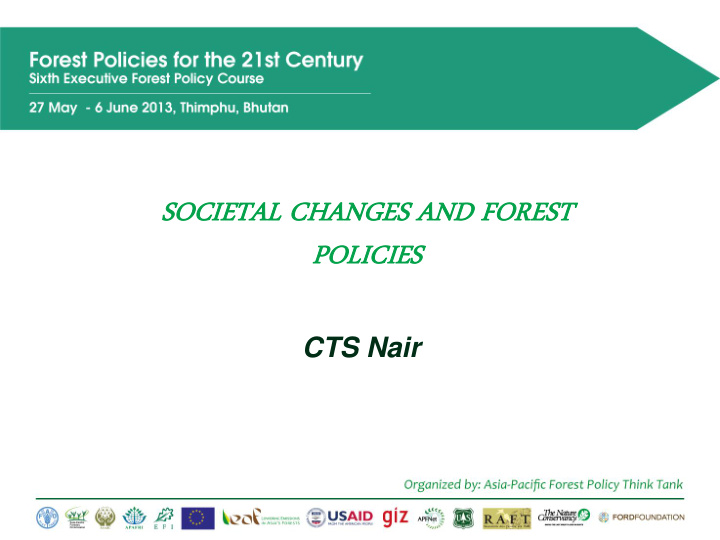



TI TITL TLE SOC OCIETAL ETAL CH CHANGE GES AND D FOR OREST T POL OLICIES ICIES CTS Nair
BACKGR CKGROUND OUND • The collective impact of the drivers of change brings about fundamental changes in the characteristics of society. • However the transition is not uniform leading to obvious segmentation in society. • Different segments in society have different uses of forests and conflicts are bound to become severe in resource-constrained situations. • Understanding the differences in societies and how they change over time become important to understand how policies need to be crafted to deal with changing resource uses and address potential conflicts.
PURPOSE RPOSE OF OF TH THIS IS SESSIO SSION • Identify the different segments in society and their diverging demands on forests. • Visualise how the composition of the society is undergoing changes and to assess the probable situation in the next two decades. • Assess the implications of societal changes on forests and forestry and how forest policies are dealing with conflicts between different segments in society. • Introduce the concept of forest transition and discuss the likelihood of forest transition in some of the Asia-Pacific countries.
UNDERSTANDI ERSTANDING NG SO SOCI CIETAL ETAL DIFFEREN FERENCES CES • Most often we are dealing with highly fragmented societies. • Differentiating different societal segments: Criteria for classification - Socio-economic conditions in particular main source of livelihood. • Possible groupings: – Pre-agrarian societies – Agrarian societies – Industrial societies – Post-industrial societies. • Forests are seen differently by different societal segments.
CHANG NGING ING DEPENDE NDENCE NCE OF SOCIET ETY ON FORES ESTS TS Society Key features of the economic system Implications on forests Forest Almost entirely subsistence focused Forests are used to meet basic needs dependent, pre- Communal production and shared consumption. such as woodfuel, medicines, food agrarian Most of the consumption is to satisfy basic needs. and construction materials; these communities Production is primarily dependent on natural factors. societies have limited capacity to Very little dependence on resources outside the area alter the forest environment controlled by the community. Practically no trade of drastically. products, except bartering with adjoining communities. Forests permeate cultural, social and religious beliefs and perceptions. Agrarian Significant differences within agrarian societies Forests are viewed as space to societies ranging from small scale subsistence farming to large expand agriculture, including scale farming focused on production of industrial raw livestock; as a source of low-cost materials. inputs for agriculture and as a supply Land and labour are the key factors of production. of woodfuel, fodder, medicines and Most livelihoods are derived from the farm land, other non-wood forest products. although some income/ products are obtained from With settled cultivation, the service adjoining common land including forests functions of forests (e.g. watershed protection, arresting land degradation) become important
CHANG NGING ING DEPENDE NDENCE NCE OF SOCIET ETY ON FORES ESTS TS Society Key features of the economic system Implications on forests Industrial Land becomes a less important factor of Forests are used as a source of societies production. industrial raw material with A high proportion of goods and services increasing emphasis on large produced is traded. Trade becomes an important scale plantations . engine of the economy. Increasing demand for energy, Large-scale production and trade, dependent on minerals, infrastructure puts mass markets. Capital and skilled labour the enormous pressure on forests main factors of production. Post-industrial Information and knowledge become Forests become less important as societies the most important inputs in production of goods a source of products and more and services. important as a source of services – e.g. watershed protection, Trade of services and knowledge becomes the main engine of the economy and most of the biodiversity conservation and products are procured from other countries by carbon sequestration. creating favourable terms of trade for knowledge Aesthetic values gain primacy. services. Shift from mass production to meeting needs of smaller markets and increased emphasis on customization.
SOC OCIETY IETY AND FOR OREST ESTS • Proportion of different societal segments now and its implications on forest policies. • How forest policies are addressing conflicts between different segments in society? Pre-agrarian Agrarian • Who calls the shot as regards the use of forests? Post- Industrial industrial • Changes in the proportion of different segments in society and what it means to forests and forestry and how forest policies need to be changed?
WHEN ? FOR OREST EST TRAN ANSITION: SITION: WH WHERE RE AN AND WH • Most national forest policies give a target as regards the proportion of forest that the country should strive to reach. • Accomplishing such targets require arresting further deforestation and degradation and increasing the extent of forests through afforestation and reforestation. • Where and when such change - forest transition - has occurred in the Asia-Pacific region?
TH THE CON ONCEPT PT OF OF FOR OREST T TR TRANSITI TION ON • The concept of forest transition largely applies the Environmental Kuznet’s curve to forests. • Forest transition implies that in the early stages of development a society intensively uses its forests with the attendant decline in area and with industrialisation and urbanisation the situation starts reversing. • – Several factors political, economic, technological, social, cultural, institutional – contribute to the transition. • Experience of forest transition.
ISSUES UES FOR OR DISCUSSION CUSSION • Are forest policies giving due consideration for the diverse needs of different segments in society? • How are conflicts between divergent needs of different segments of society resolved? • Are we likely to witness an increase in forest use related conflicts in the next few decades? • Are forest policies designed to address/ resolve such conflicts? • What are the chances of “forest transition” taking place in your country? • Does forest policies help to accomplish forest transition?
Th Than ank k Yo You
Recommend
More recommend